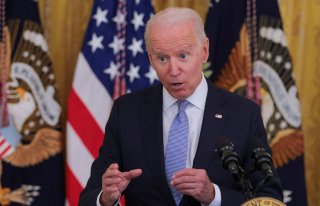Biden Called Out By Fact Checkers Over Afghan Military Strength
Fact-checkers have pounced on the president, who along with administration officials, had repeatedly claimed that the Afghan Army was up to the fight. Among the points being put under the microscope by the fact-checkers was the seemingly dubious claim of the size of the fighting force.
Since cutting short and returning from his summer vacation at Camp David, President Joe Biden has found himself on the defensive as he faces mounting criticism over his handling of the withdrawal of the U.S. military and civilians in Afghanistan. This week the president has also been repeatedly called out for stating just last month that he had believed that the Afghan military would be able to hold its own against the Taliban.
However, the country collapsed in mere weeks and is now in near entire Taliban control.
Fact-checkers have pounced on the president, who along with administration officials, had repeatedly claimed that the Afghan Army was up to the fight. Among the points being put under the microscope by the fact-checkers was the seemingly dubious claim of the size of the fighting force.
"We spent over a trillion dollars. We trained and equipped an Afghan military force of some 300,000 strong. Incredibly well equipped. A force larger in size than the militaries of many of our NATO allies. We gave them every tool they could need," Biden said during his brief remarks at the White House on Monday.
Size Matters
Among the harshest critics of Biden's claim was Glenn Kessler of the Washington Post, who cited data from The Military Balance, an annual report issued by the International Institute of Strategic Studies (IISS). Dubbed, "the gold standard," the report lists the size and capabilities of the world's armies. As the paper of record noted, "If Afghanistan actually had more than 300,000 military troops, the active force would be bigger than every NATO ally but Turkey."
However, the IISS report from 2021 actually listed an Afghanistan with an active force of just 178,800, which included 7,300 air force personnel. Where the issue gets clouded is that Afghanistan has 99,000 "paramilitary" forces, which include the Afghan National Police. While including that personnel would boost the overall numbers, the fact is that NATO countries don't have such forces so it becomes an "apples and oranges" comparison.
Likewise, the paper added that many NATO countries have reserve forces, but no reserves were listed for Afghanistan. The 300,000 number is thus achieved by including police, who would report to the Interior Ministry and not the Defense Ministry. These are not what most would describe as front-line troops, and instead are tasked with guarding the border, staffing security checkpoints, and maintaining order in regions cleared of the insurgents.
Repeated Number?
Given those aforementioned facts, the question is why did Biden make such a dubious statement? This may not have been one of his infamous flubs or gaffes, but rather is a number that has been cited by other officials.
Biden was only repeating what he may have believed to be true.
According to CNN, "the 300,000 figure was not invented by the Biden administration; the U.S. military, think tanks, and media outlets have long used that same figure or similar figure. However, the figure was never reliable. Experts told CNN this week that, for multiple reasons, the 300,000 figure significantly overstated the number of Afghans who were available to fight."
The question should then be asked if the media was beginning to question the figure why wasn't the White House? And why did the president of the United States essentially double down in his address to the American people on Monday when it is clear the numbers were grossly inflated.
Comparison to NATO
On paper, even with just 178,800 active military fighters, Afghanistan would have had a force larger than many NATO members. However, as was seen in the weeks leading up to the Taliban's capture of Kabul, it was clear that it wasn't the fighting force Biden and other officials believed—or at least stated publicly—it to be.
In fact, in terms of deployable combat forces, IISS had found that the Afghan government had only a slight numerical superiority, and maybe not even that. As it had an entire country to defend, the numbers didn't give it an advantage.
Instead, the Afghan military was a shell of what President Biden described it to be. In his fact-checking, the Washington Post's Kessler added, "Even among the active military, there is high turnover and only a small core of professionals which could be expected to fight professionally against the Taliban. In other words, the number is not 300,000—and probably not even 30,000."
It is little wonder then that the collapse occurred as quickly as it did.
Peter Suciu is a Michigan-based writer who has contributed to more than four dozen magazines, newspapers and websites. He regularly writes about military small arms, and is the author of several books on military headgear including A Gallery of Military Headdress, which is available on Amazon.com.
Image: Reuters

